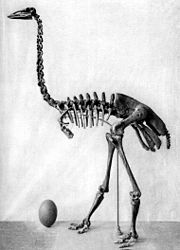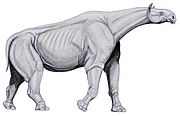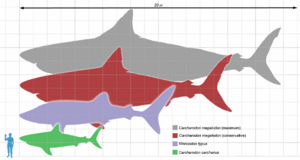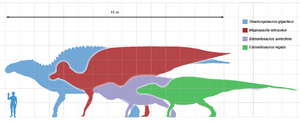Largest extinct animals facts for kids
The largest extinct animals are amazing creatures that once roamed our planet, from the deepest oceans to the highest skies. This article explores some of the biggest animals that are no longer alive, organized by their family groups. Get ready to discover some true giants!
Contents
Vertebrates
Vertebrates are animals with a backbone, like fish, reptiles, birds, and mammals.
Giant Fish
- Bony Fish
The biggest bony fish and the largest fish ever known was Leedsichthys problematicus. This huge fish lived during the Middle Jurassic period and could grow to about 17 metres (56 ft) long. That's longer than a school bus!
- Cartilaginous Fish
The extinct shark called C. megalodon was by far the largest and most powerful shark that ever lived. This giant shark could reach lengths of more than 16 metres (52 ft). Imagine a shark longer than two cars parked end-to-end! Megalodon had an incredibly strong bite.
Amazing Reptiles
Reptiles include animals like turtles, crocodiles, dinosaurs, and snakes. Many of them grew to enormous sizes!
Super-Sized Turtles
The biggest fossil turtle found so far seems to be the freshwater turtle Stupendemys. Its shell alone was estimated to be over 11 feet (3.3 metres) long. Another huge turtle was Archelon ischyros, a sea turtle. It could stretch 16 feet (4.8 m) across its flippers and weighed over 4,850 lb (2,200 kg). To compare, the largest living turtle today, the Leatherback sea turtle, weighs a maximum of 2000 lbs (900 kg).
Mighty Archosaurs
Archosaurs are a group that includes crocodiles, pterosaurs, and dinosaurs.
- Crocodiles
The largest known crocodilian was probably Sarcosuchus imperator. It was about 12 metres (39 ft) long and weighed 8 tonnes. That's like a small truck! Another giant crocodile, Deinosuchus, was also estimated to be around 12 metres (39 ft) long.
- Pterosaurs
The largest pterosaur (a flying reptile) was Quetzalcoatlus northropi. It weighed about 127 kg (280 lbs) and had a wingspan of 11 m (36 ft). That's like a small airplane! Another huge pterosaur, Hatzegopteryx, also had an estimated wingspan of 11 m.
Giant Dinosaurs
Dinosaurs were some of the most incredible giants to ever walk the Earth.
- Sauropods
Sauropods were long-necked, plant-eating dinosaurs. The titanosaurs hold the world record for the size of a land animal. A recent discovery in Argentina found Dreadnoughtus, which was estimated to be 26 metres (85 feet) long and weigh 59,291 kg (65.4 short tons). Its bones showed it was still growing!
Another famously large titanosaur was Argentinosaurus. Scientists estimate it was 30–35 metres (98–115 ft) long and weighed 73–99 metric tons. Imagine a dinosaur as long as three school buses!
- Ornithopods
The biggest ornithopods, like Shantungosaurus, were as heavy as some medium-sized sauropods, weighing up to 23 metric tons. Lambeosaurus laticaudus was also very large, around 15–16.4 metres (49–54 ft) in length.
- Theropods

Theropods were mostly meat-eating dinosaurs. The largest known theropod was Spinosaurus aegyptiacus. It's estimated to have been 15.2–17.4 metres (50–57 ft) long and weighed around 7–9 metric tons. Spinosaurus aegyptiacus is also known as the largest land predator ever.
Another giant theropod from South America was Giganotosaurus carolinii. Its main fossil was estimated at 12.5 metres (41 ft) long, and another specimen might have been 13.5 metres (44 ft) long. Other huge theropods include Carcharodontosaurus, Tyrannosaurus rex, Acrocanthosaurus, and Mapusaurus. Deinocheirus was also very large, standing 3 metres (10 ft) tall at its hips and weighing up to 16,000 pounds. The largest dromaeosaurid (a type of theropod) was Utahraptor.
- Armoured Dinosaurs
The largest thyreophoran, or armoured dinosaur, was Ankylosaurus. It was 9 metres (30 ft) long and weighed 6.5 tons. Stegosaurus was also 9 meters (30 ft) long but weighed around 5 tons.
- Ceratopsians
The largest ceratopsian (horned dinosaur) known is probably the recently discovered Eotriceratops. Its skull alone was 3 metres (10 ft) long! This dinosaur might have been around 9 metres (30 ft) long and weighed 13 tonnes.
Ocean Reptiles
- Ichthyosaurs
The largest ichthyosaur (a marine reptile that looked like a dolphin) was Shonisaurus sikanniensis. It was about 21 metres (70 ft) long, making it the largest extinct marine animal known for a while.
- Plesiosaurs
Plesiosaurs were long-necked marine reptiles. The largest plesiosaur was Mauisaurus haasti, which grew to about 20 metres (66 ft) long. Elasmosaurus was also very long at 14 metres (46 ft).
- Pliosaurs
Pliosaurs were a type of plesiosaur with shorter necks and larger heads. There's a lot of debate about the biggest pliosaur. Fossil remains of a pliosaur nicknamed Predator X were found in Norway in 2008. It was about 15 metres (49 ft) long and weighed 41 metric tons. Another giant pliosaur, the Monster of Aramberri, was found in Mexico in 2002. It was also estimated to be 15 metres (49 ft) long, but scientists think it was still a juvenile!
Giant Snakes and Mosasaurs
- Snakes
The largest known prehistoric snake was Titanoboa. It's estimated to have been 13–15 metres (43–49 ft) long and weighed between 1135 kg and 1819 kg. That's like a school bus-sized snake! Another huge fossil snake was Gigantophis, around 11 metres (36 ft) long. Both of these lived in tropical rainforests.
- Mosasaur
Giant mosasaurs were huge marine lizards. The largest known mosasaur was likely Mosasaurus hoffmanni, estimated to be at least 17.6 metres (58 ft) long. That's longer than a bowling lane! Other big mosasaurs included Hainosaurus bernardi (around 15 metres (49 ft) long) and Tylosaurus (10–15 metres (33–49 ft) long).
Enormous Birds

The largest birds of all time might have been the elephant birds of Madagascar. They were about 3 m tall (10 ft) and weighed up to 400 kg. Australia had a similar giant bird called Dromornis stirtoni, which was also about 3 m tall but weighed even more, up to 500 kg. The tallest bird ever was the Giant Moa (Dinornis maximus) from New Zealand, standing 12 ft tall.
The largest bird that could fly was Argentavis magnificens. It had a wingspan of 7 m (~23 ft) and weighed 110 kg (244 lb). Another contender for the largest flying bird was Pelagornis sandersi, with a wingspan of 6.4 to 7.4 metres.
Massive Mammals
Mammals are warm-blooded animals, including whales and land animals.
Giant Whales
Basilosaurus was once considered one of the largest extinct cetaceans (whales and dolphins), reaching 18 metres (59 ft) in length.
The largest fossil toothed whale was the Livyatan melvillei, which lived during the Miocene epoch. It was estimated to be 13.5–17.5 m (44–57 ft) long. One amazing thing about L. melvillei was its teeth, which were 36 cm long – bigger than any other animal's teeth, living or extinct!
However, the largest fossil whales were baleen whales (which filter feed on tiny organisms) from the Pliocene and Pleistocene Epochs. Some of these ancient baleen whales likely rivaled the modern blue whale in size, which is the largest animal alive today.
Huge Land Mammals

The largest land mammal of all time was Palaeoloxodon Namadicus, an ancient elephant. It stood 5.5 m (18 ft) tall at the shoulder, had a total height of 8 m (27 ft), was 12 m (40 ft) long, and may have weighed 20 tonnes (22 tons). Some prehistoric horned rhinos also grew to huge sizes. The giant woolly rhino Elasmotherium reached 20 ft long and 6.6 ft high.
Invertebrates
Invertebrates are animals without a backbone, like insects and millipedes.
Giant Myriapods
Myriapods are a group that includes millipedes and centipedes.
Enormous Millipedes
The largest millipede by far was Arthropleura. It measured 2.5 metres (8.2 ft) long and 45 centimetres (18 in) wide. This makes it the largest land arthropod (a group including insects, spiders, and crustaceans) of all time.




